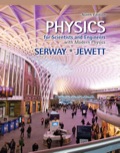
(a)
The magnitude of the relative acceleration as a function of
(a)
Answer to Problem 13.76AP
The magnitude of the relative acceleration as a function of
Explanation of Solution
A object of mass

Figure I
Formula to calculate the relative acceleration is,
Here,
Formula to calculate the gravitational force exerted by the object on the Earth is,
Here,
By Newton’s law the force exerted by the object is,
From equation (II) and equation (III) is,
The forces
Here,
Substitute
By Newton’s law the force exerted by the Earth is,
From equation (IV) and equation (V) is,
Substitute
Substitute
Conclusion:
Therefore, the magnitude of the relative acceleration as a function of
(b)
The magnitude of the relative acceleration for
(b)
Answer to Problem 13.76AP
The magnitude of the relative acceleration for
Explanation of Solution
From equation (VI) the relative acceleration is,
Substitute
Conclusion:
Therefore, the magnitude of the relative acceleration for
(c)
The magnitude of the relative acceleration for
(c)
Answer to Problem 13.76AP
The magnitude of the relative acceleration for
Explanation of Solution
From equation (VI) the relative acceleration is,
Substitute
Conclusion:
Therefore, the magnitude of the relative acceleration for
(d)
The magnitude of the relative acceleration for
(d)
Answer to Problem 13.76AP
The magnitude of the relative acceleration for
Explanation of Solution
From equation (VI) the relative acceleration is,
Substitute
Conclusion:
Therefore, the magnitude of the relative acceleration for
(e)
The pattern of variation of relative acceleration with
(e)
Answer to Problem 13.76AP
The relative acceleration is directly proportional to the mass
Explanation of Solution
From equation (VI) the relative acceleration is,
This is the linear equation and shows the relative acceleration is directly proportional to the object having mass
Conclusion:
Therefore, the relative acceleration is directly proportional to the object having mass
Want to see more full solutions like this?
Chapter 13 Solutions
EBK PHYSICS FOR SCIENTISTS AND ENGINEER
- Hi! I need help with these calculations for part i and part k for a physics Diffraction Lab. We used a slit width 0.4 mm to measure our pattern.arrow_forwardExamine the data and % error values in Data Table 3 where the angular displacement of the simple pendulum decreased but the mass of the pendulum bob and the length of the pendulum remained constant. Describe whether or not your data shows that the period of the pendulum depends on the angular displacement of the pendulum bob, to within a reasonable percent error.arrow_forwardIn addition to the anyalysis of the graph, show mathematically that the slope of that line is 2π/√g . Using the slope of your line calculate the value of g and compare it to 9.8.arrow_forward
- An object is placed 24.1 cm to the left of a diverging lens (f = -6.51 cm). A concave mirror (f= 14.8 cm) is placed 30.2 cm to the right of the lens to form an image of the first image formed by the lens. Find the final image distance, measured relative to the mirror. (b) Is the final image real or virtual? (c) Is the final image upright or inverted with respect to the original object?arrow_forwardConcept Simulation 26.4 provides the option of exploring the ray diagram that applies to this problem. The distance between an object and its image formed by a diverging lens is 5.90 cm. The focal length of the lens is -2.60 cm. Find (a) the image distance and (b) the object distance.arrow_forwardPls help ASAParrow_forward
 Principles of Physics: A Calculus-Based TextPhysicsISBN:9781133104261Author:Raymond A. Serway, John W. JewettPublisher:Cengage Learning
Principles of Physics: A Calculus-Based TextPhysicsISBN:9781133104261Author:Raymond A. Serway, John W. JewettPublisher:Cengage Learning Glencoe Physics: Principles and Problems, Student...PhysicsISBN:9780078807213Author:Paul W. ZitzewitzPublisher:Glencoe/McGraw-Hill
Glencoe Physics: Principles and Problems, Student...PhysicsISBN:9780078807213Author:Paul W. ZitzewitzPublisher:Glencoe/McGraw-Hill Classical Dynamics of Particles and SystemsPhysicsISBN:9780534408961Author:Stephen T. Thornton, Jerry B. MarionPublisher:Cengage Learning
Classical Dynamics of Particles and SystemsPhysicsISBN:9780534408961Author:Stephen T. Thornton, Jerry B. MarionPublisher:Cengage Learning University Physics Volume 1PhysicsISBN:9781938168277Author:William Moebs, Samuel J. Ling, Jeff SannyPublisher:OpenStax - Rice University
University Physics Volume 1PhysicsISBN:9781938168277Author:William Moebs, Samuel J. Ling, Jeff SannyPublisher:OpenStax - Rice University Physics for Scientists and Engineers: Foundations...PhysicsISBN:9781133939146Author:Katz, Debora M.Publisher:Cengage Learning
Physics for Scientists and Engineers: Foundations...PhysicsISBN:9781133939146Author:Katz, Debora M.Publisher:Cengage Learning Modern PhysicsPhysicsISBN:9781111794378Author:Raymond A. Serway, Clement J. Moses, Curt A. MoyerPublisher:Cengage Learning
Modern PhysicsPhysicsISBN:9781111794378Author:Raymond A. Serway, Clement J. Moses, Curt A. MoyerPublisher:Cengage Learning





